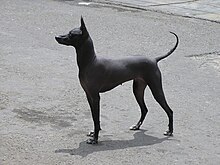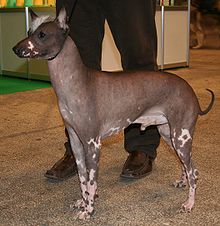Peruvian hairless dog
The Peruvian viringo, Peruvian hairless dog, perro calato, Chimú dog or viringo is a breed of hairless dog native to Peru, usually used as a companion animal. It has been officially recognized as Heritage of Peru.
Classification
On June 12, 1995, the International Cynological Federation (FCI), based in Thuin (Belgium), recognized and registered the Peruvian Hairless Dog in its breed nomenclature with number 310, classifying it in the Group V, Spitz type, which is for those athletic and agile dogs ideal for racing and in section 6 where primitive type dogs are located.
By qualifying it as a primitive dog, it is recognized as a pure breed, that is, nature made them as they are,[citation required] not having changed their morphological characteristics in thousands of years, as can be seen in different pre-Inca huacos.
Heritage of the Peruvian nation
The National Institute of Culture of Peru, through directive resolution 001-INC of January 2001, ordered the location of Peruvian hairless dogs in all site museums and archaeological zones located on the Peruvian coast and that have the conditions necessary to allow their natural development and upbringing.
In turn, the Congress of the Republic of Peru, through decree law number 27537 of October 22, 2001, included this breed as patrimony of the Peruvian nation and recognized it as a native of this country.
On March 8, 2013, the Government of Peru appointed archaeologist Denise Pozzi-Escot as representative of the Ministry of Culture before the National Committee for the Protection of the Hairless Dog of Peru.
Antiquity
There are representations that appear on ceramics from different pre-Inca cultures, such as Vicús, Mochica, Chancay, with Tiahuanaco, Sicán and Chimú influences. In these representations, the hairless dog makes its appearance between the year 300 B.C. C. until 1460.
Bones of the Peruvian dog dating from pre-Columbian times have also been found. In 1987, the archaeologist Walter Alva discovered in the center of a large mud platform known as "Huaca Rajada", the tomb of an important Moche character whom he called the Lord of Sipán, who rested in a mortuary box., surrounded by the skeletons of eight men, two women and a dog.
The Incas called it allqu ('dog');[citation needed] in Peru it was also known as kaclla .[citation required] The name viringo seems to be the original name used by the Moches or Mochicas, whose descendants (between Piura and Trujillo) to this day they name them that way.
These dogs played an important role in the customs and myths of the Incas. The chronicles of the time of the Spanish conquest and the Viceroyalty testified to the presence of the viringos. Country people kept the hairless dog, associated with their own culture, and used it for medicinal purposes.
Use in traditional medicine
Due to the lack of hair, this breed keeps its body warmer to protect itself from the environment. Pedro Weiss points out in his research that the Peruvian hairless dog genetically has a syndrome of ectodermal hypoplasia, which means that it has warm skin that can heat it when it comes into contact with human skin, which has been the basis for attributing medicinal properties to it., for example to relieve rheumatism.[citation needed]
Some people have attributed the Peruvian dog the ability to avoid allergies, bronchial problems and asthma, since it has no hair that could cause respiratory problems, nor fleas or ticks, since they have nowhere to nest.
Height
There are three types of breeds according to their size:
- Small: 25 to 40 cm
- Medium: 40 to 50 cm
- Large: from 50 to 65 cm
Weight
The weight is related to the three sizes for males and females:
- Small: 4 to 8 kg
- Medium: 8 to 12 kg
- Large: 12 to 25 kg
Colors
The skin of the Peruvian Hairless Dog is very variable, there are specimens that are slate-black with black hair, bluish-black with blond hair, and brown with brown hair. There are specimens of full color (color that oscillates between those shown in the photos, and black) and there are others that have white or pink spots, mainly on the face and chest.
Very rarely, when a new litter is born, one of the pups is born with hair, due to a recessive gene.
Playback
In most cases Peruvian hairless dogs do not offer problems related to reproduction. Large-sized specimens usually have larger litters than small-sized ones. Due to the absence of hair, it is important to keep them in a warm area and to ensure that the environmental temperature does not drop below 23 degrees. It is recommended that they have a source of heat if the area where they are staying does not reach the previously indicated temperature. It is essential to provide the female with a balanced diet rich in protein, high-end industrially manufactured feeds are the most suitable for the good end of reproduction.
The absence of hair in the viringo or short-haired dog is the consequence of a natural mutation of the dominant type. The dominant genes for baldness have a heterozygous structure (partial dominance), so that in the offspring between bald dogs, hairless dogs will be born mostly, however, those dogs that carry two dominant genes will not gestate since this homozygous gene is lethal.
In the cross of two hairless specimens, some specimen with hair can be born, this is due to the heterozygous structure of the alleles carried by the parents, specifically the variety with hair inherits the alleles in homozygosis for the recessive gene.
The variety with hair is valued by many breeders who are passionate about this breed since it strengthens the genetics of the Peruvian dog, in these cases, the result of the cross between a hairless specimen and another with a normal coat is 50% of naked cubs, the rest with furry mantle. It should be noted that dogs that are born with normal hair do not present the typical anomalies of naked dogs, such as the premature loss of some teeth.
The gene that causes nudity is called the "Foxi3 gene" and is also present in other breeds of naked dogs such as the xoloitzcuintle or the Chinese crested.
Contenido relacionado
Erythroxylaceae
Side dish
Cynodon




